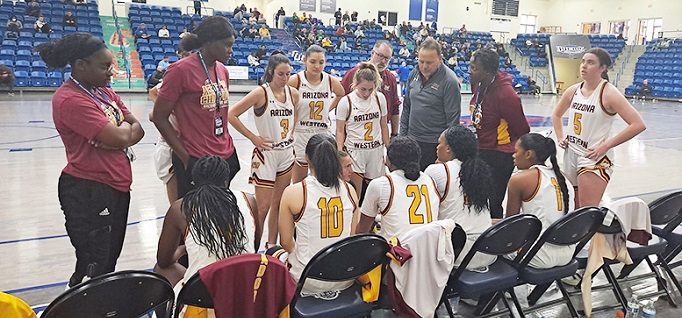Recruiting – and retaining – student athletes
By David Tobenkin
June 8, 2022
As community college campuses reopen post-Covid in an environment of declining enrollment, intercollegiate athletics programs are emerging as a potential draw for recruiting students. Serving as a key enabler of successful student-athlete programs are services that work to support student-athletes and help deliver improved student-athlete academic results.
Two presentations at the recent 2022 AACC convention highlighted these trends:
- One, “NJCAA Athletics – Maximizing Recruitment, Retention & Graduation,” by National Junior College Athletic Association (NJCAA) President Christopher Parker and several community college leaders.
- The other session, “Outside the Lines: Wraparound Student Services in Athletics,” examined Mississippi Gulf Coast Community College’s (MGCCC) use of wraparound student support services for student-athletes to improve their outcomes as both athletes and students.
Expecting an increase in athletics
As Covid precautions wane, NJCAA’s Parker is forecasting expansion of two-year athletics. His 510 members represent nearly half of the roughly 1,100 two-year colleges in the country.
“I would say over the next five years, I easily could see the needle move to 65% to 70% of all two-year colleges having some type of athletic program, though that would include eSports, which has just taken off,” he said.
While the number of members of his organization has not grown over the past two years, neither has it declined despite Covid, testimony to the value that NJCAA members place in those programs, Parker said.
Some community colleges say their sports programs have already largely recovered.
“Our attendance at various sporting events this past year has been through the roof; I think there was that pent-up demand for folks to get back,” said Daniel Corr, president of Arizona Western College, which has roughly 11,000 students. “And also I think there’s a realization across NJCAA athletics that these are really world-class athletes that we are sending on to Division 1 NCAA schools where they’re dominating right out of the box.”
Why add sports?
Adding student athletic programs can be part of the solution to declining enrollment trends at community colleges, particularly because it is an impactful, strategic decision that two-year institutions can implement relatively swiftly, Parker said.
He added that beyond just attracting more students, the student-athlete segment is, on average, more successful than average potential students at large with respect to providing a high return on investment. On average, student-athletes are more readily recruitable than the population at large, have higher retention rates and have higher completion rates.
Student athletics can also help with diversity and equity concerns, Parker said.
“What we’ve heard from college presidents all over the country is there’s a lack of male students; athletic programs can bring that diversity to your campus,” Parker said. “And certain sports can bring greater ethnic diversity. Soccer programs, for example, typically have strong Hispanic and Latino population and international population student draws.”
Colleges must do a cost-versus-benefit analysis to see if the costs of a program are offset by benefits, Parker said. That can depend, in part, on state-specific factors, since in some states two-year institutions can use state funding to support athletics whereas this is not allowed in others. The capacity of institutions to operationally fundraise to support athletic programs also varies and can be a key factor in allowing athletics program expansions, as such funding sources often contribute to, or cover, the operational costs of athletics programs.
It can also depend on the sport. Corr noted that Arizona Western discontinued a football program four years ago that was disproportionately expensive given the large size of the team and high equipment, travel and insurance costs.
Bringing back some sports
Meanwhile, several community colleges that had previously dropped certain athletic programs are now bringing them back. Alabama’s Gadsden State Community College announced in May that it will reinstate its baseball and softball teams beginning this fall, as well as its men’s and women’s cross country teams.
“We believe this is a good way to recruit, enroll, retain and support students. We are providing them a good collegiate experience,” said President Kathy Murphy.
The college’s baseball and softball teams were disbanded in 2011 and 2016, respectively. Murphy said the decision to reinstate the programs came after a community meeting in January to gauge public interest. A committee of local supporters discussed and researched the possibility of the reinstatement.
Assistance beyond sports
Wraparound academic services supporting community college athletes are becoming commonplace, and they are delivering results both on the playing field and in student academic outcomes, noted MGCCC vice presidents Ladd Taylor and Tammy Franks in their AACC presentation.
The services include things like athletic academic advisor support, faculty support, student services support, support from coaches, mentoring, learning resources (tutoring) and administrative support. They also include services available to the general student body, such as a hands-on approach to financial aid, monitoring its early alert system to detect students who may be having problems, and financial literacy, among others.
At MGCCC, which has 10 NJCAA-sanctioned sports, use of wraparound services for student-athletes contributed to 100% of its student-athletes graduating, completing or transferring in the 2020-21 academic year, resulting in the college winning the David M. Halbrook Award from the Mississippi Association of Community College Athletics. MGCCC has won the Halbrook award five times since 2010, Taylor noted.
The course pass rate of MGCCC student-athletes has consistently topped the rate for the general student body from 2017 through 2021, ranging from 94% to 95% for student-athletes compared to the 87% to 88% rate of the general population. Full-time student fall-to-spring retention rates show a similar superior performance for student-athletes as compared to the student population as a whole.
That has not come at the cost of strong athletic performance, as a string of MGCCC championships in various sports from recent years demonstrates, Taylor said.
Wraparound services are essential to enabling those types of successes, according to Taylor and other community college leaders. While many of the services provided to student-athletes are available to all students, what is different for student-athletes is their participation is those services is mandatory.
The necessity of wraparound service participation for these students become clear once student-athlete obligations are examined. Community college athletes must maintain a 2.0 grade point average to be eligible to compete under NJCAA rules, and some regional accreditation bodies have even higher standards.
This can be challenging for many student-athletes during playing seasons, when every hour must be scripted to ensure that academics, training, traveling and competing are fit into students’ tight schedules.
There’s more to the story! Read the full article in CC Daily.



